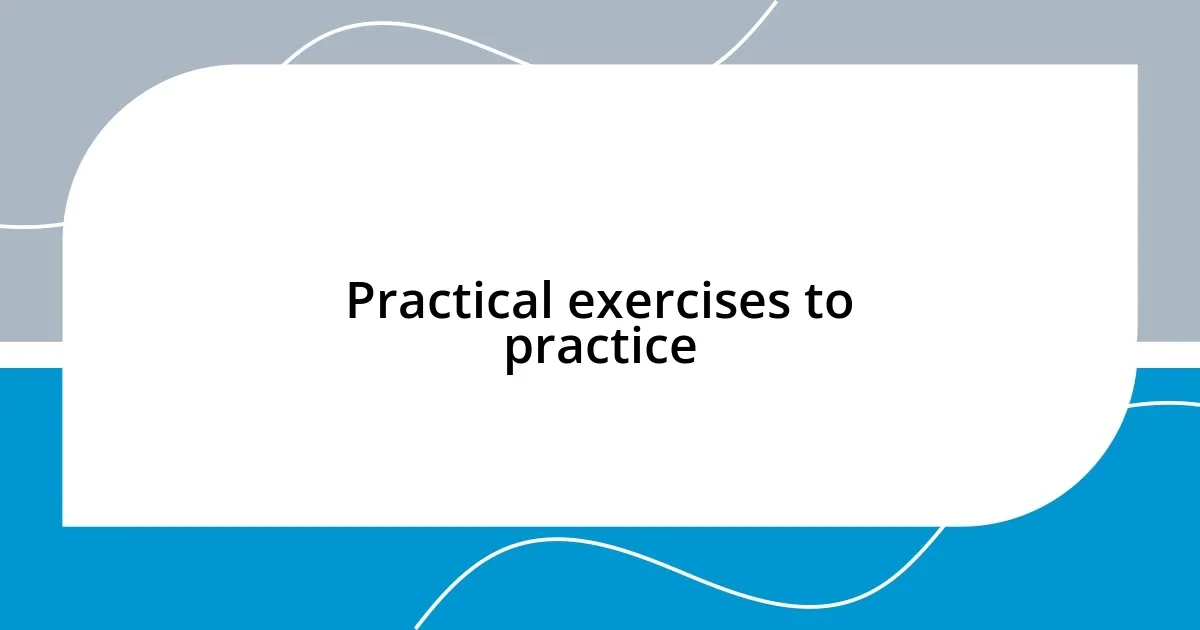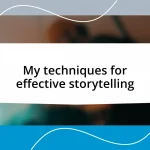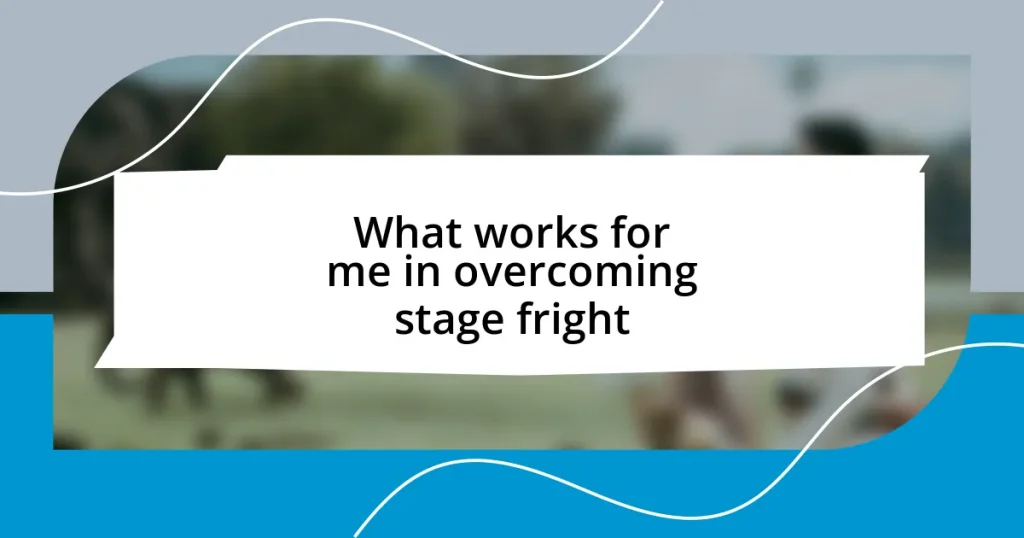Key takeaways:
- Technical skills are multi-dimensional, enabling creative problem-solving and innovation beyond mere functionality.
- Creativity enriches technical processes, allowing for more engaging and meaningful outcomes in projects.
- Collaboration and diverse perspectives enhance the blending of technical skills with creativity, fostering innovative solutions.
- Practical exercises, like daily creative prompts and participating in hackathons, can effectively integrate technical and creative abilities.

Understanding technical skills
When I think of technical skills, I picture a well-crafted toolbox. Each skill serves a unique purpose—like a hammer, screwdriver, or wrench—allowing us to tackle various challenges in our work. Have you ever felt that satisfaction when solving a complex problem using a specific skill? It’s like the rush of a puzzle piece fitting perfectly into place.
Many people see technical skills as dry and purely analytical, but there’s so much more beneath the surface. I remember a time when I learned programming; it felt like learning a new language. I didn’t just acquire syntax; I discovered how to think differently, approach problems creatively, and express ideas in a structured manner. Why do we often underestimate the artistry behind coding or design?
Understanding technical skills also means recognizing their role in innovation. It’s not just about knowing how to use them; it’s about knowing when and where to apply them for maximum impact. That realization hit me during a project where I merged coding and visual design. It was incredible to see how the two elements interacted, leading to a final product that not only functioned well but also resonated with users on an emotional level.

The importance of creativity
Creativity is the spark that ignites innovation in our technical endeavors. I recall a moment when I was stuck on a project, feeling ground down by routine processes. It was creativity that led me to explore unconventional solutions—like sketching out ideas on a whiteboard or brainstorming with peers in a relaxed setting—that turned my stagnation into inspiration. Have you ever felt that sudden clarity after a creative breakthrough? It’s transformative.
The ability to think creatively allows us to see beyond the confines of established methods. In one of my past projects, I combined my coding skills with graphic design to produce an engaging user interface. It struck me how a simple color choice could influence user engagement, showing that creativity does not merely embellish technical skills; it enhances them.
Embracing creativity can lead us to solutions that are not just functional but also meaningful. One particularly memorable experience was when I introduced storytelling elements into my presentations. Discovering that weaving a narrative can breathe life into data made me realize that creativity is not just about art—it’s a vital part of communication and connection. It left an imprint on how I approach not only work but life itself.
| Creative Process | Technical Process |
|---|---|
| Fluid and often unpredictable | Structured and systematic |
| Generates new ideas and possibilities | Refines existing concepts to improve efficiency |
| Encourages exploration | Focuses on application |
| Stimulates emotional responses | Prioritizes logical outcomes |

Integrating skills and creativity
Integrating technical skills with creativity isn’t just about being proficient; it’s about how those skills can transform ideas into reality. I remember a time while working on an app, I decided to use my coding knowledge not just to build functionality but to create an immersive user experience. By incorporating elements of color theory and user psychology, I learned how a well-thought-out interface could evoke feelings of trust and excitement. It’s fascinating how blending these worlds can lead to more engaging and impactful outcomes.
When it comes to integration, consider these ideas:
- Use design thinking to guide technical projects, ensuring that user needs are prioritized.
- Experiment with different techniques outside of your main field to bring fresh perspectives.
- Regularly collaborate with individuals from diverse disciplines for innovative approaches.
- Keep a creative journal to document ideas that arise while working on technical tasks.
This mix of thought can elevate any project and make the process more enjoyable.

Examples of blending skills
One of the most exciting instances of blending my skills happened while I was developing an interactive website for a local charity. I leveraged my programming knowledge to implement a features-rich platform, but it was my passion for storytelling that truly brought the project alive. I saw how integrating compelling narratives about the charity’s mission helped to connect emotionally with users. Isn’t it amazing how a well-told story can make technical elements resonate on a deeper level?
In another project, I was part of a team focusing on data visualization tools. While my colleagues excelled in the technical aspects, I made it my mission to infuse artistic elements into our reports. I experimented with colors and shapes, designing infographics that not only conveyed data but also captivated our audience. This experience taught me that creativity can turn even the driest information into something that sparks curiosity. Have you ever looked at data and felt nothing? I learned how to change that narrative through engaging design.
Additionally, there was a time when I chose to fuse my skills in video editing with animation. I had a vision to create a tutorial series that would be both educational and visually appealing. By mixing these two disciplines, I was able to explain complex concepts in a fun way that kept viewers engaged. When did you last see a tutorial that captivated you? This blend of creativity and technical know-how set my work apart, leading to positive feedback and increased viewership.

Tools that enhance creativity
The right tools can significantly enhance creativity and support our technical skills. For instance, I’ve found that using a digital sketchpad not only helps with brainstorming ideas but also allows me to visualize concepts instantly. Have you ever felt stuck in the abstract before? Sketching out thoughts can clear the fog and pave the way for a creative breakthrough.
Another tool that has transformed my creative process is mind mapping software. I remember a time when I was planning a complex project; organizing my ideas visually made all the difference. It felt like I was unraveling a tangled ball of yarn, where each thread represented a piece of the puzzle. Mind maps encouraged connections I hadn’t seen before and led me to innovative solutions.
Moreover, I’ve embraced collaborative platforms like Miro or Trello, which allow for real-time brainstorming with others. It’s exhilarating to see how quickly diverse minds can generate ideas! When I worked on a tech initiative with a varied team, the input from different backgrounds challenged us all to think outside our usual boundaries. It was a vivid reminder that creativity thrives in an environment where dialogue and collaboration intertwine.

Overcoming challenges in blending
Blending technical skills with creativity often presents hurdles that require a little introspection and adaptability. I remember grappling with a coding project where I felt bogged down by rigid programming structures. It wasn’t until I challenged myself to experiment with unconventional coding techniques that I discovered new avenues for creativity; this leap of faith paid off in the form of smoother, more intuitive designs. Have you ever felt stifled by rules? Sometimes, it takes a fresh perspective to unlock hidden potential.
On another note, collaboration can also be a double-edged sword when blending these skills. I once participated in a brainstorming session where my technical teammates were laser-focused on functionality, leaving little room for imaginative input. As we revisited our ideas, I advocated for a balance, encouraging us to incorporate artistic elements alongside our tech-oriented plans. The transition wasn’t smooth, but by fostering an open dialogue, we all learned to value diverse perspectives. Isn’t it interesting how collaboration can challenge our comfort zones?
Lastly, I’ve faced moments where I’ve felt overwhelmed by the sheer scope of merging creativity with technical tasks. There was a project where I was tasked with developing an innovative app while ensuring it remained user-friendly. I found myself swimming in countless features that I wanted to implement. To overcome this, I prioritized the user experience above all, simplifying my focus on how the user would interact with the app. This realization transformed my approach, turning a daunting challenge into an opportunity to create something meaningful. Have you ever simplified an overwhelming task only to find clarity?

Practical exercises to practice
One practical exercise I often recommend is to challenge yourself with daily creative prompts that also incorporate technical skills. For instance, I set aside time each morning to create a small piece of code that achieves something visually appealing, such as generating a unique pattern or animation. Have you ever noticed how constraints can actually fuel creativity? This practice pushes me to think creatively within technical frameworks, helping me merge both worlds more fluidly.
Another great way to enhance this blending is through hackathons or creative jams, where you have limited time to work on projects. I once participated in a 24-hour hackathon that focused on creating art with technology. The adrenaline rush of working against the clock forced me to let go of perfection and just create. Isn’t it fascinating how time can dictate our creative processes? That experience opened my eyes to new forms of expression that I may not have explored otherwise.
Lastly, I like to turn to personal projects that excite me—those little ideas that pop up during an idle moment. I recently built a simple web application, purely for fun, which showed the beauty of nature through color palettes inspired by photographs I took. It was refreshing! Engaging with something I genuinely love not only strengthens my technical skills but also ignites a real passion for creativity. Have you considered pursuing a project solely based on your interests? You might be surprised at what emerges when you follow your passion.
















